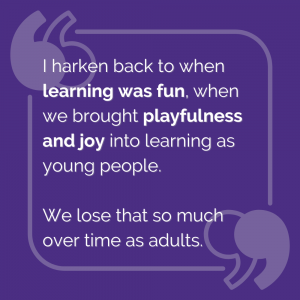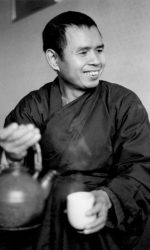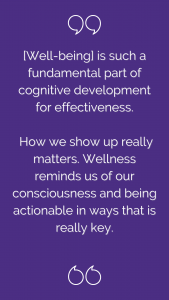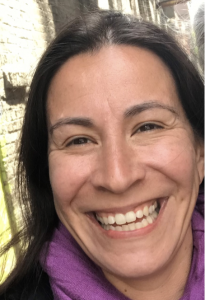May 24, 2022
Ariana Cantu Presents: Strategies for Cultivating Collective Wellness
5/6/2022 – Victoria Robinson
This article is a recap of the Teaching & Learning Symposium Keynote presentation, hosted by the Center for Teaching and Learning. For more information on the full week of symposium presentation, as well as the full recording of the keynote lecture, visit the Teaching & Learning Symposium Event page.
Ariana Cantu, MSW, lecturer in the UW School of Social Work (and longtime friend of the Resilience Lab), offers us a five-part guide for incorporating well-being into our work at the University of Washington. These strategies, cultivated through the collective knowledge of community leaders and educators, address the role of instructors in a heightened political and cultural context, asking us: What kind of support do students need to be well, and what is our responsibility to cultivate wellness in the classroom?
Strategy 1: Setting the Tone
 Cantu opens the keynote with a dance session to Prince’s Let’s Go Crazy, warming up the teaching space as Zoom participants swayed and bopped in their small square. And good thing, too: evidence shows that there are strong connections between movement and improved cognition, and that movement can be an effective cognitive strategy to 1) strengthen learning, 2) improve memory and retrieval, and 3) enhance motivation.
Cantu opens the keynote with a dance session to Prince’s Let’s Go Crazy, warming up the teaching space as Zoom participants swayed and bopped in their small square. And good thing, too: evidence shows that there are strong connections between movement and improved cognition, and that movement can be an effective cognitive strategy to 1) strengthen learning, 2) improve memory and retrieval, and 3) enhance motivation.
While online education has increased the accessibility of lectures and workshops, the chronic stress of the continuing pandemic has acted as a major detriment for learners’ ability to digest material. Combined with hours of sitting still at a desk and the distractions inherent in the home environment, the task of teaching became even more challenging. Instructors are seeking new ways to build engaging curriculums, from kindergarten to higher-education, using movement to stimulate learning, thought, and creativity from the entire body.
But for Cantu, dancing is also a conduit for meaningful interaction between the instructor, the student, and their classmates, especially when some students are hesitant to get moving: “When you can help people identify what leads to fear of public action like dancing, often times it is the same thread that stops people from showing up in other ways. [Dancing] is a tool.” Students who are more engaged in their class are not only more likely to absorb the material, but also to build more open and honest relationships with each other.

Strategy 2: Highlight Indigenous Wisdom and Contributions
Our educational structures, firmly rooted in colonialization and capitalism, are not built for everyone. Discrimination and racial bias against students of color begins as early as preschool, and white students have significant advantages in college admission and retention. In addition, students of color are often held at fault for not improving their educational achievement, despite the barriers in their way. Part of this disconnect is the culture in the classroom – how are we encouraging students to learn? Are we challenging tenets of racism and white supremacy culture, or are we politely omitting them from our curriculums? Are we validating the experiential knowledge of students whose backgrounds don’t align with Western knowledge?
If you’ve attended an event or class at the University of Washington, you’ve probably seen an administrator, educator, or community leader offer a Land Acknowledgment to “offset” the colonialism inherent in our institution. However, Cantu says that true equity involves going beyond acknowledgement and into intentionality, naming specific injustices that Indigenous peoples experienced on this land, as well as the ways we can commit to healing: “One of the ways we can stay engaged in long-term wellness practice is to cultivate that knowledge of history and contextualize it around complexity, around humility, and countering settler culture.”
Moving past the performative and into action requires intentional efforts to build relationships with Indigenous practitioners and leadership, developing curriculums that engrain the long-standing wisdom into the lessons we’re teaching our students. “Indigenous communities remind us, and land-based wisdom has tremendous things to teach us,” Cantu asserts. “[One thing] I learned during the pandemic was… How can [students] get outside? How can we breathe? How can we reconnect to the earth, reset our minds and be prepared for absorbing learning in the moment?”
Strategy 3: The Concept of Interbeing
For her third strategy, Cantu emphasizes the wise words of Thich Nhat Hanh as a core of her practice, as a social worker, as an instructor, and as a person:
 Interbeing is the understanding that nothing exists separately from anything else. We are all interconnected. By taking care of another person, you take care of yourself. By taking care of yourself, you take care of the other person. Happiness and safety are not individual matters. If you suffer, I suffer. If you are not safe, I am not safe. The is no way for me to be truly happy if you are suffering. If you can smile, I can smile too. The understanding of interbeing is very important. It helps us to remove the illusion of loneliness and transform the anger that comes from the feeling of separation.
Interbeing is the understanding that nothing exists separately from anything else. We are all interconnected. By taking care of another person, you take care of yourself. By taking care of yourself, you take care of the other person. Happiness and safety are not individual matters. If you suffer, I suffer. If you are not safe, I am not safe. The is no way for me to be truly happy if you are suffering. If you can smile, I can smile too. The understanding of interbeing is very important. It helps us to remove the illusion of loneliness and transform the anger that comes from the feeling of separation.
Thich Nhat Hanh
The value of interbeing spans from individuals to global systems. By teaching interbeing, instructors create a space where students not only directly experience the benefits of support in the classroom, but also understand the practical application of these theories in our reality.
“Using the context of this through a global exchange with the University of Namibia provides an opportunity for students to connect theories around interconnectedness, around concepts of Ubuntu, concepts around kinship care, and really understanding the benefits that come from fore-fronting those connections.”
Strategy 4: Make Wellness an Assignment
 Cantu gave the Resilience Lab an exciting shout-out for her next strategy, highlighting our Well-Being for Life and Learning initiative as a resource for instructors designing learning environments that promote well-being. As a collective effort from UW faculty, students, and staff who are practicing well-being in the classroom, the WBLL initiative combines the research, resources, and best practices that are shown to improve students’ experience in the classroom.
Cantu gave the Resilience Lab an exciting shout-out for her next strategy, highlighting our Well-Being for Life and Learning initiative as a resource for instructors designing learning environments that promote well-being. As a collective effort from UW faculty, students, and staff who are practicing well-being in the classroom, the WBLL initiative combines the research, resources, and best practices that are shown to improve students’ experience in the classroom.
Just like dancing, making wellness a significant part of your curriculum has marked effects, not only enhancing academic performance and bolstering students’ stress-coping skills, but increasing students’ compassion towards themselves and each other. “[Well-being] is such a fundamental part of cognitive development for effectiveness,” says Cantu. “How we show up really matters. Wellness reminds us of our consciousness and being actionable in ways that is really key.”
Strategy 5: Advocacy
Lastly, Cantu stresses how important it is for instructors to speak up for well-being in the classroom – not only for their students, but for themselves. Especially during the pandemic, educators are well-placed for advocacy, acting as a liaison between students and administration during a time when new processes and strategies are emerging. “We all have a role to play in asking for what we need,” says Cantu. “We don’t do this often enough and fall silent. We don’t name the elephants in the room, and we participate in harm, and we harm each other when we do that.” Instructors who are in tune with the classroom climate (and their own wellness) are able to center needed interventions and advocate for changes.
In closing, Cantu reminds us of the immense potential for social and emotional learning that prioritizes well-being. “There are tremendous things that we can do when we work together. We need each other at this point, if that’s not clear. We all need each other to be well. I am glad to be with you all in this work.”
We’re glad to be with you in this work too, Ariana.
 Ariana Cantu, MSW (she/her/ella) is a lecturer at the University of Washington School of Social Work. As a queer, Latinx woman who has spent 24 years as an organizer and social work practitioner, she has worked alongside diverse populations to address inequity, lack of access to basic needs, homelessness and poverty. She is guided by a community-centered ethic, both for the profession in social justice work and in the classroom, to be engaged in activities that lead to the collective liberation for us all. She has decades of community organizing and legislative advocacy experience and utilizes those skills to prepare students for the complex needs of communities, non-profit organizations, and public entities.
Ariana Cantu, MSW (she/her/ella) is a lecturer at the University of Washington School of Social Work. As a queer, Latinx woman who has spent 24 years as an organizer and social work practitioner, she has worked alongside diverse populations to address inequity, lack of access to basic needs, homelessness and poverty. She is guided by a community-centered ethic, both for the profession in social justice work and in the classroom, to be engaged in activities that lead to the collective liberation for us all. She has decades of community organizing and legislative advocacy experience and utilizes those skills to prepare students for the complex needs of communities, non-profit organizations, and public entities.
Links:
Center for Teaching and Learning, University of Washington (2022)
Teaching & Learning Symposium Event Page (2022)
Well-Being for Life and Learning Initiative (2022)
Ariana Cantu, MSW, University of Washington School of Social Work
References:
Douglas, B., Lewis, C.W., Doublas, A., Earl Scott, M., Garrison-Wade, D. (2008). The impact of white teachers on the academic achievement of black students: An exploratory qualitative analysis. Educational Foundations, 22(1-2), 47-62.
Jensen, E. (2008). Teaching with the brain in mind (2nd ed.). Association for Supervision and Curriculum Development. https://www.ascd.org/books/teaching-with-the-brain-in-mind-2nd-edition?chapter=movement-and-learning
Kamwanyah, N., Freeman, R. J., & Rose-Junius, H. (2021). Social Welfare and Social Work in Namibia: Systems in Progression. In N. Noyoo (Ed.), Social Welfare and social work in Southern Africa (pp. 173–193). essay, African Sun Media.
Okun, T. (2021). Characteristics. WHITE SUPREMACY CULTURE. Retrieved May 3, 2022, from https://www.whitesupremacyculture.info/characteristics.html
Okun, T. (2021). What is it? WHITE SUPREMACY CULTURE. Retrieved May 3, 2022, from https://www.whitesupremacyculture.info/what-is-it.html
Perszyk, D. R., Lei, R. F., Bodenhausen, G. V., Richeson, J. A., & Waxman, S. R. (2019). Bias at the intersection of race and gender: Evidence from preschool‐aged children. Developmental Science, 22(3). https://doi.org/10.1111/desc.12788
Shapiro, D., Dundar, A., Huie, F., Wakhungu, P., Yuan, X., Nathan, A & Hwang, Y., A. (2017). Completing College: A national view of student attainment rates by race and ethnicity – Fall 2010 Cohort. NSC Research Center.
https://nscresearchcenter.org/signaturereport12-supplement-2/
Tsoi-A-Fatt Bryant, R. (2015, February). College preparation for African American Students: Gaps in the high school educational experience. Washington, DC; CLASP.
